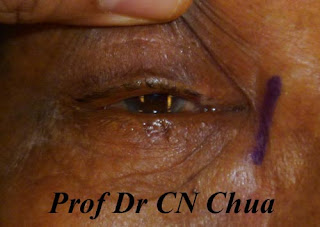Abscess of the tear (lacrimal) sac is a painful condition and caused by blockage of the nasolacrimal duct (see picture below) which connects the sac to the nose. This unfortunate Austrian nun of the 17th century had this affiliation and was treated surgically without anaesthesia (which had yet to be discovered). She was tied up in the chair and restrained by other nuns whie a priest with a sharp knife cut the abscess to drain it.
A print from a 17th century Austrian medical textbook.
A close-up of the nun after the incision
This patient had chronic mucous discharge due to blocked duct.
A mark is made where skin would be made to create a connection
between the lacrimal sac and the nasal cavity.
Syringing of the lacrimal sac caused the mucous discharge
to enter the eye.
The skin is incised and the muscles pushed aside to reveal
the bone (white in colour).
The nasal bone is removed with a bone crusher.
A hole is made in the nasal bone to reveal the nasal mucosa.
A cut is made in the nasal mucosa to form a flap.
The lacrimal (tear) sac is cut to form flap.
A tube is inserted to keep the passage patent.
The tube is pulled though the nose and tied.
The flaps from the nasal cavity and the lacrimal sac
are stitched together,

The skin incision is sutured.
The illustration summarizes the procedure above.
The second one had the sac removed. The patient had a seious road traffic accident 5 years ago resulting in lost of the right eye and multiple facial bone fractures. There was recurrent abscess formation which was incised and drained. As the patient had complex orbital and nasal bone fractures, I decided not to perform dacryocystorhinostomy (DCR) and instead remove the entire sac.
Before and one week after excision of the tear sac.

















No comments:
Post a Comment